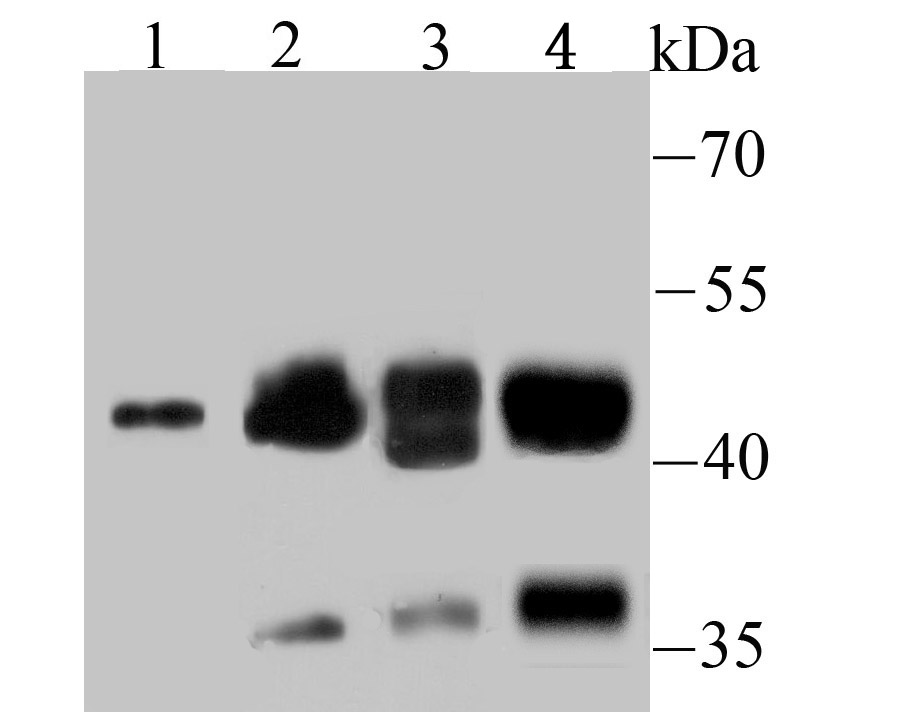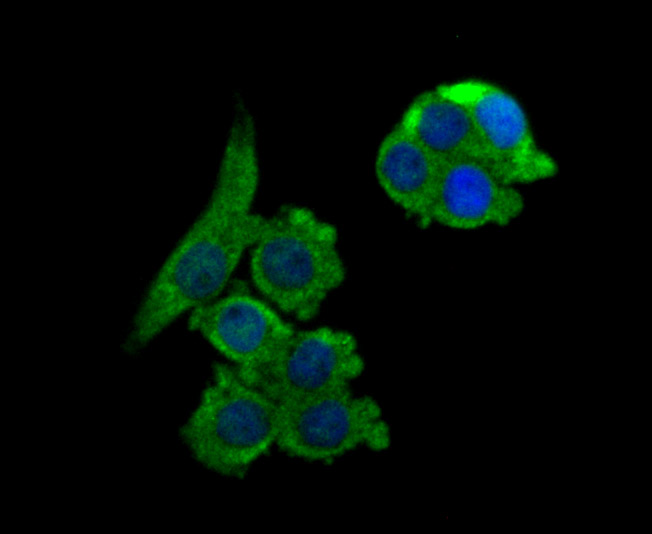Product Name :
NCK1 polyclonal antibody Background :
The NCK family of SH2/SH3 adaptor proteins consists of two members, NCK1 (NCKα) and NCK2 (NCKβ), which couple tyrosine kinase signaling, including the EGF and PDGF receptor-pathways, to downstream signaling proteins. Specifically, overexpression of Nck1 in NIH/3T3 cells decreases DNA synthesis stimulated by EGF. Furthermore, the SH2 domain of NCK2 inhibits EGF- and PDGF-induced DNA synthesis. The SH3 domain of NCK binds a proline-rich domain on PAK, a known actin cytoskeleton regulator. The NCK protein thus mediates the interaction between PAK and RAC. The NCK2 protein binds human PDGFR-b (Tyr 1009); overexpression of Nck2 inhibits PDGF-induced membrane ruffling and lamellipod formation. Various growth factor receptors, cell surface antigens and adhesion molecules phosphorylate mammalian NCK1 and NCK2. The human NCK1 and NCK2 genes map to chromosomes 3q22.3 and 2q12.2, respectively. Product :
Rabbit IgG, 1mg/ml in PBS with 0.02% sodium azide, 50% glycerol, pH7.2 Storage&Stability :
Store at +4°C after thawing. Aliquot store at -20°C or -80°C. Avoid repeated freeze / thaw cycles. Specificity :
NCK1 polyclonal antibody detects endogenous levels of NCK1 protein. Immunogen :
Recombinant protein Conjugate :
Unconjugated Modification :
Unmodification
NCK1 polyclonal antibody Background :
The NCK family of SH2/SH3 adaptor proteins consists of two members, NCK1 (NCKα) and NCK2 (NCKβ), which couple tyrosine kinase signaling, including the EGF and PDGF receptor-pathways, to downstream signaling proteins. Specifically, overexpression of Nck1 in NIH/3T3 cells decreases DNA synthesis stimulated by EGF. Furthermore, the SH2 domain of NCK2 inhibits EGF- and PDGF-induced DNA synthesis. The SH3 domain of NCK binds a proline-rich domain on PAK, a known actin cytoskeleton regulator. The NCK protein thus mediates the interaction between PAK and RAC. The NCK2 protein binds human PDGFR-b (Tyr 1009); overexpression of Nck2 inhibits PDGF-induced membrane ruffling and lamellipod formation. Various growth factor receptors, cell surface antigens and adhesion molecules phosphorylate mammalian NCK1 and NCK2. The human NCK1 and NCK2 genes map to chromosomes 3q22.3 and 2q12.2, respectively. Product :
Rabbit IgG, 1mg/ml in PBS with 0.02% sodium azide, 50% glycerol, pH7.2 Storage&Stability :
Store at +4°C after thawing. Aliquot store at -20°C or -80°C. Avoid repeated freeze / thaw cycles. Specificity :
NCK1 polyclonal antibody detects endogenous levels of NCK1 protein. Immunogen :
Recombinant protein Conjugate :
Unconjugated Modification :
Unmodification
-
 Western blot analysis of NCK1 on different lysates using anti-NCK1 antibody at 1/500 dilution. Positive control: Lane 1: Hela Lane 1: NIH-3T3 Lane 2: Rat kidney tissue Lane 3: Mouse testis tissue
Western blot analysis of NCK1 on different lysates using anti-NCK1 antibody at 1/500 dilution. Positive control: Lane 1: Hela Lane 1: NIH-3T3 Lane 2: Rat kidney tissue Lane 3: Mouse testis tissue -
 ICC staining NCK1 in LOVO cells (green). The nuclear counter stain is DAPI (blue). Cells were fixed in paraformaldehyde, permeabilised with 0.25% Triton X100/PBS.
ICC staining NCK1 in LOVO cells (green). The nuclear counter stain is DAPI (blue). Cells were fixed in paraformaldehyde, permeabilised with 0.25% Triton X100/PBS.
Bioworld Biotech only provide peptides for our antibodies and do not provide additional peptide customization services.
Price/Size :
USD 368/1mg/vial
Tips:
For phospho antibody, we provide phospho peptide(0.5mg) and non-phospho peptide(0.5mg).Describe :
Blocking peptides are peptides that bind specifically to the target antibody and block antibody binding. These peptide usually contains the epitope recognized by the antibody. Antibodies bound to the blocking peptide no longer bind to the epitope on the target protein. This mechanism is useful when non-specific binding is an issue, for example, in Western blotting (WB) and Immunohistochemistry (IHC). By comparing the staining from the blocked antibody versus the antibody alone, one can see which staining is specific; Specific binding will be absent from the western blot or IHC performed with the neutralized antibody.Formula:
Synthetic peptide was lyophilized with 100% acetonitrile and is supplied as a powder. Reconstitute with 0.1 ml DI water for a final concentration of 10 mg/ml.The purity is >90%,tested by HPLC and MS.
Storage:
The freeze-dried powder is more stable. For short time at 2-8°C. For long term storage store at -20°C.
Note :
This product is for research use only (RUO only). Not for use in diagnostic or therapeutic procedures.
 NCK1 polyclonal antibody
NCK1 polyclonal antibody  Datasheet
Datasheet COA
COA MSDS
MSDS SHIP
SHIP